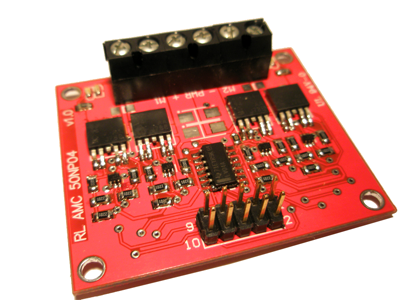RL-AMC-50NP04 is an advanced Full H-Bridge board based on high performance MOSFETs capable of driving two high power DC motors. It has been designed to achieve a great efficiency and usage simplicity since just 3 pins are needed to control a motor. Based on the large experience working with Robotics we designed this board keeping in mind some important factors such as power dissipation, heating, simplicity and functionalities like braking, bi-directional control of the motors and a wide range of PWM frequencies from 3.3v or 5V microcontrollers.
Its small size makes this H-Bridge MOSFET board perfect to fit in your Robotics designs: 50 x 42 mm (1,97 x 1,65 inch) .
Main features:
- 2 high power DC Motors control.
- PWM frequencies up to 20 KHz for speed control.
- Bi-directional control.
- Braking function (coast and brake functions).
- 3.3v / 5V logic capable.
- Up to 8A continuous operation with very low internal resistance (0.038 ohms).
- Up to 35A pulsed current.
- Wide range of power supply voltage ranging from 3 to 40V.
- Current sense (just 6mV per amp to minimize the total voltage drop when high currents are demanded).
- Just 3 pins needed from your microcontroller to drive each motor.
- Two LEDs per leg indicating the rotating direction of each motor.
- Easy interface connections through an standard 10-pin male header.
- Three two-pin terminal blocks for connecting the motors and their power supply.
- Logic power supply ranging from 2V to 6V.
Here you can see the output of the board when driving one of its LEDs with a voltage supply of 8,4V. The voltage drop accross the LED is about 1 Volt and in this graphic you can appreciate that the rising and falling times are extremely small since it has been designed for operating in high-speed environments with the maximum efficiency. This minimizes the transition time of the MOSFETs (time when their internal Rds resistance is higher) and, thus, also minimizes the total power dissipation due to switching power losses.
If you are interested in this board or have any further questions / suggestions don’t hesitate to contact me.
Documentation:
- RL-AMC-50NP04 Quick Reference Guide
- RL-AMC-50NP04 Reference Source Code (for interfacing it from the LPC2138-01 board)
More to come,
Daniel

